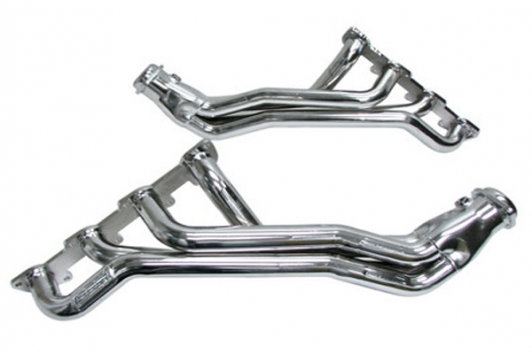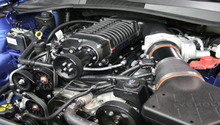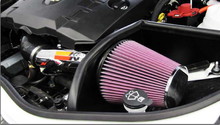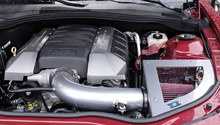Camaro and Firebird: Engine Modifications
Although your Camaro or Firebird are powerful cars, there is always room for more. Read on to learn about the effective engine modification.
This article applies to the Camaro and Firebird (1990-2015).
The LS1 engine is one of the most potent, and easily modified engines in modern history. They respond well to everything from basic bolt-on power upgrades, to big power adders like turbocharging or nitrous-oxide. We are going to cover two basic upgrades for the Camaro or Firebird enthusiast who is just starting out, and round it off with a more work-intensive, but rewarding power mod. If your powertrain is all original, get educated on the basics of bolt-on performance.
Engine Performance Modification

#1 Cold Air Intake

DIY Cost – $100-350
Professional Cost – $250-500
Skill Level – Easy; the intake on LS engines is front and center in the engine bay, so it is easy to replace.
Cold air intakes are air intakes that generally offer longer tubing, which goes lower to the ground, usually near the wheel well, to extract air from down below. The principle is simple, heat rises, and tends to get trapped in the engine bay. If your intake is ingesting "clean" non-heated air, it will make more power as lower air temperatures means greater air density.
The factory-equipped "lid" on the LS1 engine is pretty efficient, especially so if your Camaro is an SS model with the optional SLP lid. That said, there are still gains to be had with aftermarket air intakes, especially when paired with an aftermarket intake manifold (a la FAST 102) and a good tune. Additionally, opening up the intake really gives the LS engine a throaty roar at full song. The sound upgrade alone is worth it.
Related Video: K&N Air Intake Video for LT1 and LS1 V8 Engine
#2 Headers

DIY Cost – $300-800
Professional Cost – $500-1000
Skill Level – Moderate; this job requires the removal of various components, and working in a tight area.
If you're looking for an appreciable power bump, and are okay with a bit of hard labor (it's worth it!), it's time to look into headers. Your Camaro comes from the factory with exhaust manifolds that help exhaust gasses exit the engine and then through the exhaust. The stock manifolds are made of heavy, cast iron, and are formed with the goal of being as compact as possible for ease of assembly when the car was going down the line, back in Michigan. Aftermarket exhaust manifolds, called headers, have longer, smoother bends, and are often made of substantially lighter stainless steel. Headers have larger ports and tubing diameter, combined with the smoother flowing bends means that exhaust gasses are able to escape more efficiently, making more power.
Let's not beat around the bush, installing headers on the LS engine is a bit of a pain, but it's worth it. The LS engine loves to breathe, so it will make appreciable gains on the dyno, especially with a good tune, and sound awesome doing it.
Related Video: Camaro LS1 Borla Exhaust and Headers
#3 Turbocharger

DIY Cost – $2,000-8,000
Professional Cost – $3,000-10,000
Skill Level – Difficult; even with a pre-fabricated kit, installing a turbo setup requires a lot of disassembly and work.
So you want to skip the naturally-aspirated power mod pathway and go the way of boost. I don't blame you, feeling 10psi worth of boost light up the rear tires is entirely too much fun. Turbochargers, the turbo manifold, and associated plumbing required for the charge side replace the exhaust headers and the entirely of the intake system.
Sounds complicated, right? So how does turbocharging work? In a nutshell, as your car accelerates, the engine produces exhaust gasses, which pass through the manifold and the turbocharger, spinning it up to help force air through the turbine and into the engine. With a turbocharger, from start to finish, the setup usually goes like this: air goes through the intake; which gets feed into the turbine, which is spun by used exhaust gasses to force more air into that charge, this is referred to as "boost," commonly measure in PSI; that pressurized, charged air is very hot, so it usually goes through an intercooler, which works like an air-cooled radiator to cool down that charged air; from there, the charged and cooled air is run through the charge piping, through the throttle body, and finally into the intake manifold where it feeds the engine, ultimately creating more exhaust gasses to keep the turbo spooled up.

If you couldn't already guess, turbocharging is very expensive, and it really is a case of you getting back what you put into it. You'll need the turbo, turbo manifold, intercooler, hot and cold side piping, oil feed lines for the turbo and a bunch of other odds and ends including an excellent tuning solution, so you don't turn your LS1 into a turbo-charged paperweight when you bend a rod.
Additionally, turbochargers come in different sizes for different applications. A larger turbo will has the capacity to make greater top end power, at the expense of requiring more exhaust gasses (time) to build up boost. A smaller turbo will spool instantly, and make tremendous torque but tend to run out of steam near the top of the RPM band. Match your turbo to you goals, basically. There is a lot of math and science behind turbocharging any car, but if you want to make big horsepower with your LS, boost is the way to go, and we highly encourage you to jump on the forums and get reading.
Related Video: Turbo LSX F-Body
Related Discussions
- Increase Horsepower - LS1Tech.com
- Performance Upgrade - LS1Tech.com
- Startup Modifications - LS1Tech.com
- 346ci LS Engine with 76mm Turbo Build - LS1Tech.com
- Budget Turbo Build - LS1Tech.com






